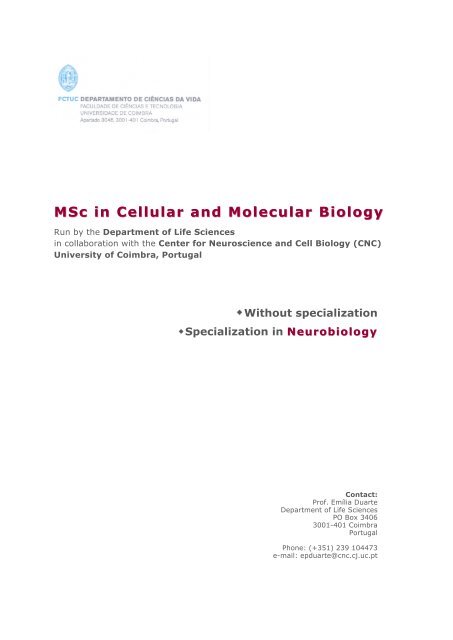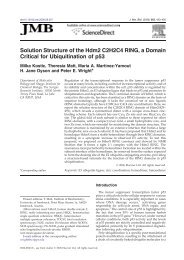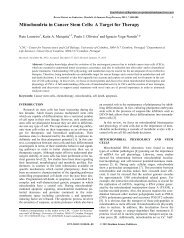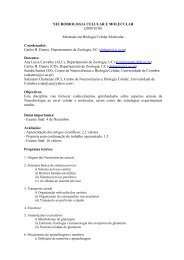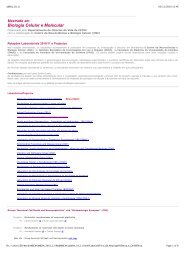MSc in Cellular and Molecular Biology MSc in Cellular and ...
MSc in Cellular and Molecular Biology MSc in Cellular and ...
MSc in Cellular and Molecular Biology MSc in Cellular and ...
Create successful ePaper yourself
Turn your PDF publications into a flip-book with our unique Google optimized e-Paper software.
<strong>MSc</strong> <strong>in</strong> <strong>Cellular</strong> <strong>and</strong> <strong>Molecular</strong> <strong>Biology</strong><br />
Run by the Department of Life Sciences<br />
<strong>in</strong> collaboration with the Center for Neuroscience <strong>and</strong> Cell <strong>Biology</strong> (CNC)<br />
University of Coimbra, Portugal<br />
Without specialization<br />
Specialization <strong>in</strong> Neurobiology<br />
ology<br />
Contact:<br />
Prof. Emília Duarte<br />
Department of Life Sciences<br />
PO Box 3406<br />
3001-401 Coimbra<br />
Portugal<br />
Phone: (+351) 239 104473<br />
e-mail: epduarte@cnc.cj.uc.pt
Index<br />
Page<br />
WHY choose the <strong>MSc</strong> <strong>in</strong> <strong>Cellular</strong> <strong>and</strong> <strong>Molecular</strong> <strong>Biology</strong> .............................. 1<br />
HOW - The programme at a glance ............................................................ 2<br />
WHAT for ................................................................................................. 2<br />
Curriculum<br />
Without specialization ...................................................................... 3<br />
Specialization <strong>in</strong> Neurobiology .......................................................... 4<br />
Admission requirements <strong>and</strong> Application .................................................. 5<br />
Tuition fees ............................................................................................. 5<br />
Short description of the courses (aims <strong>and</strong> content outl<strong>in</strong>e) .......................... 6
WHY choose the <strong>MSc</strong> <strong>in</strong> <strong>Cellular</strong> <strong>and</strong> <strong>Molecular</strong> <strong>Biology</strong><br />
The Master of Science <strong>in</strong> <strong>Cellular</strong> <strong>and</strong> <strong>Molecular</strong> <strong>Biology</strong> provides advanced,<br />
research-oriented tra<strong>in</strong><strong>in</strong>g <strong>in</strong> emerg<strong>in</strong>g areas of <strong>Molecular</strong> Cell <strong>Biology</strong>,<br />
required for the underst<strong>and</strong><strong>in</strong>g of the mechanisms of life <strong>and</strong> disease, <strong>and</strong> of<br />
the modern diagnostic tools <strong>and</strong> therapies, particularly <strong>in</strong> Neuroscience,<br />
Toxicology, Cancer, Human Reproduction <strong>and</strong> Fertility. The curriculum<br />
<strong>in</strong>cludes discipl<strong>in</strong>es <strong>in</strong> Exact Sciences that have been crucial for the<br />
advancement of knowledge <strong>in</strong> <strong>Biology</strong> <strong>and</strong> Biomedic<strong>in</strong>e.<br />
The programme takes advantage of the close collaboration exhist<strong>in</strong>g at the<br />
University of Coimbra between several Departments of the Faculty of<br />
Science <strong>and</strong> Technology (FCTUC), from the close relationship to some<br />
Research Centers, particularly the Center for Neuroscience <strong>and</strong> Cell<br />
<strong>Biology</strong> (CNC), <strong>and</strong> to laboratories of the Faculty of Medic<strong>in</strong>e <strong>and</strong> the<br />
Hospitals of the University of Coimbra (HUC). This unique research <strong>and</strong><br />
cl<strong>in</strong>ic environment makes it possible to have courses taught by lead<strong>in</strong>g<br />
national <strong>and</strong> foreign scientists, <strong>and</strong> tra<strong>in</strong><strong>in</strong>g <strong>in</strong> both research <strong>and</strong><br />
hospital laboratories.<br />
The Master program <strong>in</strong> <strong>Cellular</strong> <strong>and</strong> <strong>Molecular</strong> <strong>Biology</strong> evolved from the former<br />
Master <strong>in</strong> Cell <strong>Biology</strong> dat<strong>in</strong>g from 1982. Every year, about 20 students<br />
attended the Advanced Courses of CNC <strong>and</strong> carried out their research projects<br />
at several Departments of FCTUC (Zoology, Biochemistry, Botanic <strong>and</strong><br />
Chemistry Departments), at CNC, at the Faculty of Pharmacy, at the Center of<br />
Histocompatibility, at the Institute of Forensic Medic<strong>in</strong>e, <strong>and</strong> at the Institute<br />
of Biomedical Research <strong>in</strong> Light <strong>and</strong> Image (IBILI) of the Faculty of Medic<strong>in</strong>e<br />
of Coimbra. Currently, there are students carry<strong>in</strong>g out their research projects<br />
at Janssen Pharmaceutica (Belgium), <strong>and</strong> agreements for the exchange of<br />
students were settled with the University of Trieste, the University of Sannio<br />
<strong>and</strong> the University of Bari (Italy).<br />
1
HOW - The programme at a glance<br />
The <strong>MSc</strong> <strong>in</strong> <strong>Cellular</strong> <strong>and</strong> <strong>Molecular</strong> <strong>Biology</strong> is a two-year Master degree. The<br />
course programme <strong>in</strong> the first year comprises Courses, Laboratory<br />
Rotations <strong>and</strong> Sem<strong>in</strong>ars. The second year is dedicated full time to the<br />
research project, thesis writ<strong>in</strong>g <strong>and</strong> defence.<br />
The courses, three- or four-weeks long, comprise lectures, practical lectures<br />
<strong>and</strong> laboratory classes. The teach<strong>in</strong>g faculty <strong>in</strong>cludes national <strong>and</strong> foreign<br />
scientists com<strong>in</strong>g from other universities <strong>in</strong> Portugal or abroad. Some of the<br />
courses are l<strong>in</strong>ked to the Advanced Courses of the Doctoral Programme<br />
<strong>in</strong> Experimental <strong>Biology</strong> <strong>and</strong> Biomedic<strong>in</strong>e of CNC. The curriculum is<br />
designed to expose students to top research areas <strong>and</strong> to <strong>in</strong>stigate the<br />
development of analytical, technical <strong>and</strong> communicative skills required of<br />
today's biologists.<br />
The core courses aim at provid<strong>in</strong>g all the students, hav<strong>in</strong>g a diverse<br />
background, with the fundamental concepts <strong>and</strong> experimental tools <strong>in</strong><br />
<strong>Molecular</strong> Cell <strong>Biology</strong>. The rich diversity of optional courses allows the<br />
students to choose their own pathway.<br />
In the laboratory rotations the students participate, dur<strong>in</strong>g four weeks, <strong>in</strong><br />
research projects go<strong>in</strong>g on <strong>in</strong> research laboratories at the University of<br />
Coimbra <strong>and</strong> associated Research Centers, at the Hospitals of Coimbra or the<br />
Biocant Technology Park. The laboratory rotations provide the students with a<br />
rich diversity of modern technologies <strong>and</strong> scientific questions, <strong>and</strong> allow the<br />
students to get acqua<strong>in</strong>ted with laboratories they can jo<strong>in</strong> to do their thesis<br />
project.<br />
The research project or tra<strong>in</strong>eeship is <strong>in</strong>troduced <strong>in</strong> the first year of the<br />
programme with a literature survey <strong>and</strong> the writ<strong>in</strong>g of a review (Sem<strong>in</strong>ar I)<br />
on the subject the student is plann<strong>in</strong>g to work <strong>in</strong> the second year. At the end<br />
of the first year, the student presents <strong>and</strong> discusses the research plan of the<br />
project or tra<strong>in</strong>eeship (Sem<strong>in</strong>ar II).<br />
The second year is fully dedicated to the research or technical work, with<br />
regular presentations of the work progress.<br />
WHAT for<br />
The <strong>MSc</strong> <strong>in</strong> <strong>Cellular</strong> <strong>and</strong> <strong>Molecular</strong> <strong>Biology</strong> is a Research Master, <strong>in</strong>tended to<br />
prepare highly qualified professionals, with scientific <strong>and</strong> technical skills to<br />
work <strong>in</strong> Health, Industry, Basic <strong>and</strong> Applied Research <strong>and</strong> Academic<br />
Teach<strong>in</strong>g. Most of the students proceed to a PhD degree.<br />
2
Curriculum<br />
<strong>MSc</strong> <strong>in</strong> <strong>Cellular</strong> <strong>and</strong> <strong>Molecular</strong> <strong>Biology</strong> (without specialization)<br />
Year 1<br />
Scientific<br />
field<br />
Semester<br />
Core courses 24<br />
<strong>Cellular</strong> Regulation BCM 1 6<br />
Laboratory Rotation I BCM 1 6<br />
Laboratory Rotation II BCM 2 6<br />
Sem<strong>in</strong>ar I BCM 2 3<br />
Sem<strong>in</strong>ar II BCM 2 3<br />
Optional courses 36<br />
Year 2<br />
<strong>Biology</strong> of Addiction NEURO 1 6<br />
<strong>Biology</strong> of Reproduction BIO 1 6<br />
Biomaterials BIOQ 1 6<br />
Biomedical NMR <strong>and</strong> <strong>Molecular</strong> Imag<strong>in</strong>g BIOQ 1 6<br />
<strong>Cellular</strong> <strong>and</strong> <strong>Molecular</strong> Neurobiology NEURO 1 6<br />
Endocr<strong>in</strong>e Disrupters BIO 1 6<br />
<strong>Molecular</strong> Biotechnology BIOQ 1 6<br />
Toxicity <strong>and</strong> Disease BIO 1 6<br />
Ag<strong>in</strong>g BIO 2 6<br />
Bioenergetics BIO 2 6<br />
Bioentrepreneurship EMP 2 6<br />
Biomathematics MAT 2 6<br />
Eat<strong>in</strong>g Disorders <strong>and</strong> Metabolic Diseases BIO 2 6<br />
Functional Lipidomics BIOQ 2 6<br />
Instrumentation FIS 2 6<br />
<strong>Molecular</strong> <strong>and</strong> Cl<strong>in</strong>ical Genetics BCM 2 6<br />
<strong>Molecular</strong> <strong>Biology</strong> of Cancer BCM 2 6<br />
<strong>Molecular</strong> Microbiology BIOQ 2 6<br />
Neurobiology <strong>and</strong> Disease NEURO 2 6<br />
Pharmaceuticals <strong>and</strong> Aditives BIOQ 2 6<br />
Laboratory Rotation III BCM 2 6<br />
Free Option* 1 or 2 6<br />
Thesis/Project/Tra<strong>in</strong>eeship BCM 1 <strong>and</strong> 2 60<br />
ECTS<br />
* Students may take other discipl<strong>in</strong>es, up to 6 ECTS, <strong>in</strong> other scientific fields <strong>and</strong> <strong>in</strong> any Faculty of<br />
the University of Coimbra. Approval by the <strong>MSc</strong> coord<strong>in</strong>ator is required.<br />
(BCM, <strong>Cellular</strong> <strong>and</strong> <strong>Molecular</strong> <strong>Biology</strong>; BIO, Integrative <strong>Biology</strong>; BIOQ, Biochemistry; EMP,<br />
Entrepreneurship; FIS, Physics; MAT, Mathematics; NEURO, Neurobiology)<br />
3
<strong>MSc</strong> <strong>in</strong> <strong>Cellular</strong> <strong>and</strong> <strong>Molecular</strong> <strong>Biology</strong><br />
– Specialization <strong>in</strong> Neurobiology<br />
Year 1<br />
Scientific<br />
field<br />
Semester<br />
Core courses 36<br />
<strong>Cellular</strong> Regulation BCM 1 6<br />
<strong>Cellular</strong> <strong>and</strong> <strong>Molecular</strong> Neurobiology NEURO 1 6<br />
Laboratory Rotation I BCM 1 6<br />
Neurobiology <strong>and</strong> Disease NEURO 2 6<br />
Laboratory Rotation II BCM 2 6<br />
Sem<strong>in</strong>ar <strong>in</strong> Neurobiology I NEURO 2 3<br />
Sem<strong>in</strong>ar <strong>in</strong> Neurobiology II NEURO 2 3<br />
Optional courses 24<br />
Year 2<br />
<strong>Biology</strong> of Addiction NEURO 1 6<br />
<strong>Biology</strong> of Reproduction BIO 1 6<br />
Biomaterials BIOQ 1 6<br />
Biomedical NMR <strong>and</strong> <strong>Molecular</strong> Imag<strong>in</strong>g BIOQ 1 6<br />
Endocr<strong>in</strong>e Disrupters BIO 1 6<br />
<strong>Molecular</strong> Biotechnology BIOQ 1 6<br />
Toxicity <strong>and</strong> Disease BIO 1 6<br />
Ag<strong>in</strong>g BIO 2 6<br />
Bioenergetics BIO 2 6<br />
Bioentrepreneurship EMP 2 6<br />
Biomathematics MAT 2 6<br />
Eat<strong>in</strong>g Disorders <strong>and</strong> Metabolic Diseases BIO 2 6<br />
Functional Lipidomics BIOQ 2 6<br />
Instrumentation FIS 2 6<br />
<strong>Molecular</strong> <strong>and</strong> Cl<strong>in</strong>ical Genetics BCM 2 6<br />
<strong>Molecular</strong> <strong>Biology</strong> of Cancer BCM 2 6<br />
<strong>Molecular</strong> Microbiology BIOQ 2 6<br />
Pharmaceuticals <strong>and</strong> Aditives BIOQ 2 6<br />
Laboratory Rotation III BCM 2 6<br />
Free Option* 1 or 2 6<br />
Thesis <strong>in</strong> Neurobiology NEURO 1 <strong>and</strong> 2 60<br />
ECTS<br />
* Students may take other discipl<strong>in</strong>es, up to 6 ECTS, <strong>in</strong> other scientific fields <strong>and</strong> <strong>in</strong> any Faculty of<br />
the University of Coimbra. Approval by the <strong>MSc</strong> coord<strong>in</strong>ator is required.<br />
(BCM, <strong>Cellular</strong> <strong>and</strong> <strong>Molecular</strong> <strong>Biology</strong>; BIO, Integrative <strong>Biology</strong>; BIOQ, Biochemistry; EMP,<br />
Entrepreneurship; FIS, Physics; MAT, Mathematics; NEURO, Neurobiology)<br />
4
Admission requirements <strong>and</strong> Application<br />
Admission requirements<br />
C<strong>and</strong>idates should hold a Bachelor's degree/First degree (180 ECTS) <strong>in</strong> the<br />
field of Life Sciences (<strong>Biology</strong>, Biochemistry, Biomedical Sciences, Pharmacy),<br />
with a f<strong>in</strong>al classification of at least 14 (out of 20). Applicants with lower<br />
grades might be considered if they have additional technical/research<br />
experience (research tra<strong>in</strong>eeship, Erasmus). Degrees <strong>in</strong> other fields might be<br />
considered provided the c<strong>and</strong>idates prove their <strong>in</strong>terest for Life Sciences at the<br />
cellular <strong>and</strong> molecular level.<br />
Selection criteria<br />
• Grades of first degree<br />
• Additional experience<br />
• Field of Bachelor/first degree<br />
• Motivation letter<br />
• Interview (if requested)<br />
Application deadl<strong>in</strong>es <strong>in</strong> 2013<br />
First call: February 16 - April 15<br />
Second call: June 15 - July 15<br />
Further <strong>in</strong>formation at www.uc.pt/c<strong>and</strong>idatos<br />
Applications onl<strong>in</strong>e at http://www.uc.pt/go/c<strong>and</strong>idaturas<br />
Tuition fees<br />
2013-2015 Edition: 1500 € per year.<br />
5
Short description of the courses (aims <strong>and</strong> content outl<strong>in</strong>e)<br />
Core courses<br />
<strong>Cellular</strong> Regulation (S1, 6 ECTS, BCM) Sept 9 - Oct 11, 2013<br />
This course aims at provid<strong>in</strong>g up-to-dated <strong>in</strong>formation <strong>in</strong> selected areas of contemporary <strong>Molecular</strong><br />
<strong>and</strong> Cell <strong>Biology</strong>. Some of the critical scientific evidences that have lead to the formulation of the<br />
central concepts are addressed.<br />
Content: Target<strong>in</strong>g <strong>and</strong> transport of prote<strong>in</strong>s <strong>in</strong> the cell. Cell adhesion <strong>and</strong> communication.<br />
Intercellular messengers <strong>and</strong> their receptors. Intracellular signal<strong>in</strong>g pathways: role of prote<strong>in</strong><br />
k<strong>in</strong>ases <strong>and</strong> phosphatases. Regulation of gene expression by growth factors, cytok<strong>in</strong>es <strong>and</strong><br />
hormones. Degradation of prote<strong>in</strong>s at the lysosomes <strong>and</strong> by the ubiquit<strong>in</strong>-proteasome pathway.<br />
The cell cycle: regulation by <strong>in</strong>tr<strong>in</strong>sic <strong>and</strong> extr<strong>in</strong>sic mechanisms. Programmed cell death.<br />
<strong>Cellular</strong> <strong>and</strong> <strong>Molecular</strong> Neurobiology (S1, 6 ECTS, NEURO) Nov 11 - Dec 6, 2013<br />
This course aims at provid<strong>in</strong>g up-to-dated <strong>in</strong>formation regard<strong>in</strong>g the structure <strong>and</strong> function of the<br />
cells of the nervous system. Some of the critical scientific evidences that have lead to the<br />
formulation of the central concepts <strong>in</strong> the field are addressed.<br />
Content: Axon <strong>and</strong> dendritic transport: role of the cytoskeleton; motor prote<strong>in</strong>s; anterograde <strong>and</strong><br />
retrograde transport; cellular components transported along axons <strong>and</strong> dendrites. Experimental<br />
strategies to change neuronal activity us<strong>in</strong>g non-electrophysiological tools. <strong>Molecular</strong> mechanisms<br />
of exocytosis. Neurotransmitters <strong>and</strong> their receptors: synthesis, storage <strong>and</strong> release of<br />
neurotransmitters; receptor structure <strong>and</strong> function. <strong>Cellular</strong> <strong>and</strong> molecular basis of learn<strong>in</strong>g <strong>and</strong><br />
memory formation: long-term synaptic potentiation (LTP) <strong>and</strong> long-term synaptic depression<br />
(LTD); traffick<strong>in</strong>g of glutamate receptors; role of prote<strong>in</strong> phosphorylation <strong>and</strong> gene expression.<br />
Neurobiology <strong>and</strong> Disease (S2, 6 ECTS, NEURO) March 10 - April 4, 2014<br />
The first part of the course provides <strong>in</strong>formation about the major steps operat<strong>in</strong>g dur<strong>in</strong>g the<br />
development of the nervous system, <strong>and</strong> the cellular <strong>and</strong> molecular mechanisms <strong>in</strong>volved: neural<br />
<strong>in</strong>duction <strong>and</strong> pattern formation; cellular determ<strong>in</strong>ation, axon pathf<strong>in</strong>d<strong>in</strong>g; synapse differentiation<br />
<strong>and</strong> elim<strong>in</strong>ation; role of programmed cell death.<br />
The second part aims at provid<strong>in</strong>g up-to-dated <strong>in</strong>formation regard<strong>in</strong>g major diseases of the nervous<br />
system: epilepsy, stroke <strong>and</strong> ischemia, schizophrenia, Park<strong>in</strong>son’s disease, Alzheimer’s disease,<br />
prions disease, polyglutam<strong>in</strong>e expansion disease.<br />
Some of the critical scientific evidences that have lead to the formulation of the central concepts <strong>in</strong><br />
Neurobiology are addressed <strong>in</strong> the course.<br />
Laboratory Rotations I <strong>and</strong> II (S1/2, 6 ECTS, BCM)<br />
The students work, for at least three weeks, <strong>in</strong> research projects go<strong>in</strong>g on <strong>in</strong> laboratories of the<br />
Center for Neurosciences <strong>and</strong> Cell <strong>Biology</strong>, of the Faculty of Medic<strong>in</strong>e <strong>and</strong> of the Hospitals of the<br />
University of Coimbra (or others to be approved). Laboratory rotations provide the development of<br />
technical skills <strong>and</strong> the opportunity to get acqua<strong>in</strong>ted with scientific questions <strong>in</strong> several areas of<br />
Life Sciences that use cell <strong>and</strong> molecular biology approaches <strong>and</strong> tools. Dur<strong>in</strong>g the laboratory<br />
rotations, the students get to know laboratories <strong>and</strong> potential supervisors for their thesis project.<br />
Laboratories <strong>in</strong> Cell <strong>Biology</strong>, <strong>Molecular</strong> <strong>Biology</strong>, Structural <strong>Biology</strong>, Biophysics, <strong>Molecular</strong><br />
Biotechnology, Gene Therapy, <strong>Biology</strong> of Reproduction <strong>and</strong> Fertility, Citogenetics, <strong>Molecular</strong><br />
Genetics, Forensic Sciences, Microbiology, <strong>Molecular</strong> Oncobiology, <strong>and</strong> Neuroscience are available.<br />
6
Sem<strong>in</strong>ar I (S2, 3 ECTS, BCM)<br />
or Sem<strong>in</strong>ar <strong>in</strong> Neurobiology I (S2, 3 ECTS, NEURO)<br />
July, 2014<br />
At the end of the first year, the students carry out a literature survey <strong>and</strong> write a short review on<br />
the subject of their thesis.<br />
Sem<strong>in</strong>ar II (S2, 3 ECTS, BCM)<br />
or Sem<strong>in</strong>ar <strong>in</strong> Neurobiology II (S2, 3 ECTS, NEURO)<br />
July, 2014<br />
At the end of the first year, the students write <strong>and</strong> present the research proposal for their thesis.<br />
Sem<strong>in</strong>ars I <strong>and</strong> II stimulate the development of skills to master <strong>in</strong>formation, to organize a plan of<br />
research, <strong>and</strong> to underst<strong>and</strong> the context, aims, methods <strong>and</strong> limitations of a research proposal.<br />
Optional courses<br />
Ag<strong>in</strong>g (S2, 6 ECTS, BIO) April 7 - May 16, 2014<br />
The course provides knowledge on the age-associated molecular changes <strong>in</strong> cells <strong>and</strong> tissues, <strong>and</strong><br />
how they affect organ <strong>and</strong> body function. Based on this knowledge <strong>and</strong> on research studies on<br />
animal models, the theories of ag<strong>in</strong>g <strong>and</strong> the “evolutionary reasons” for ag<strong>in</strong>g are discussed. The<br />
course is organized around three central topics: how we age, why we age, what we can do about it.<br />
Content: Ag<strong>in</strong>g of the sk<strong>in</strong> <strong>and</strong> connective tissues: consequences <strong>in</strong> the vascular <strong>and</strong> respiratory<br />
systems, <strong>in</strong> cartilage <strong>and</strong> bone. Loss of muscle mass <strong>and</strong> changes <strong>in</strong> fiber type <strong>and</strong> function. Bra<strong>in</strong><br />
ag<strong>in</strong>g <strong>and</strong> neurodegeneration. Stress <strong>and</strong> ag<strong>in</strong>g: the bra<strong>in</strong> circuits of stress <strong>and</strong> the hormonal<br />
response to adverse conditions; effects of stress on bra<strong>in</strong> ag<strong>in</strong>g; stress <strong>and</strong> memory; relationship<br />
between stress <strong>and</strong> depression; stress <strong>and</strong> the immune system. Stochastic <strong>and</strong> systemic theories<br />
of ag<strong>in</strong>g. Cell senescence <strong>and</strong> the telomeric theory of ag<strong>in</strong>g. Stem cell ag<strong>in</strong>g. Mitochondria,<br />
oxidative stress <strong>and</strong> ag<strong>in</strong>g. “Inflammag<strong>in</strong>g”. Gene profill<strong>in</strong>g of ag<strong>in</strong>g. Trade-off theories between<br />
the costs of reproduction <strong>and</strong> the costs of tissue repair. Cancer <strong>and</strong> ag<strong>in</strong>g: is there a trade-off<br />
Strategies to delay ag<strong>in</strong>g <strong>and</strong> age-related diseases: vitam<strong>in</strong> <strong>and</strong> hormone supplements; physical<br />
exercise <strong>and</strong> ag<strong>in</strong>g; stem cells <strong>and</strong> tissue repair; caloric restriction.<br />
Bioenergetics (S2, 6 ECTS, BCM) Not open <strong>in</strong> 2013-2014<br />
The course provides the underst<strong>and</strong><strong>in</strong>g of the fundamental concepts of cell bioenergetics, with<br />
emphasis on mitochondria function.<br />
Content: Redox cha<strong>in</strong> <strong>and</strong> phosphorilative system. Chemiosmotic theory <strong>and</strong> alternative<br />
hypotheses. Stoichiometry <strong>and</strong> thermodynamics of phosphorylation. Measurement of proton motive<br />
force. The basis of respiratory control. Mitochondria as a pharmacological target. Mitochondrial<br />
permeability transition (MPT) <strong>and</strong> oxidative stress. Role of the MPT on the toxicity of xenobiotics.<br />
Role of the MPT <strong>in</strong> ischemia/reperfusion. Mitochondrial bioenergetics <strong>and</strong> heart disease: activation<br />
of K ATP <strong>and</strong> cardioprotection; role of ischemic precondition<strong>in</strong>g <strong>in</strong> cardioprotection; therapeutic<br />
strategies to change the metabolism of ischemic heart; effects of cardioprotective pharmacological<br />
agents on mitochondrial bioenergetics. Mitochondrial bioenergetics <strong>and</strong> neurodegenerative<br />
diseases. Mitochondria as a tool on toxicological evaluation (screen<strong>in</strong>g of toxic xenobiotics <strong>and</strong> use<br />
<strong>in</strong> ecotoxicology).<br />
Bioentrepreneurship (S2, 6 ECTS, EMP) March 10 - April 4, 2014<br />
The course aims to stimulate the entrepreneurship capability of the students, <strong>and</strong> to provide an<br />
overview of the procedures required to set up a bus<strong>in</strong>ess, with emphasis on technology-based<br />
entrepreneurship <strong>and</strong> bioentrepreneurship.<br />
Content: From the idea to the bus<strong>in</strong>ess: prelim<strong>in</strong>ary study of viability; bus<strong>in</strong>ess plan; fund<strong>in</strong>g;<br />
mechanisms <strong>and</strong> agencies to assist the entrepreneur. Basic accounts <strong>and</strong> f<strong>in</strong>ance. Management of<br />
human resources.<br />
7
<strong>Biology</strong> of Addiction (S1, 6 ECTS, NEURO) Dec 9, 2013 - Jan 17, 2014<br />
The course provides <strong>in</strong>-depth knowledge on the physiology of the nervous system, from cells <strong>and</strong><br />
molecules to the system level. Teach<strong>in</strong>g is carried out <strong>in</strong> the context of the action of drugs of abuse<br />
<strong>in</strong> the nervous system <strong>and</strong> their effects on physiology <strong>and</strong> behavior. Teach<strong>in</strong>g is largely based on<br />
research data so that students get acqua<strong>in</strong>ted with bra<strong>in</strong> research tools, from cell <strong>and</strong> molecular<br />
biology to bra<strong>in</strong> imag<strong>in</strong>g <strong>and</strong> behavioral assays.<br />
Content: From the mechanisms of synaptic potentiation by the stimulants coca<strong>in</strong>e <strong>and</strong><br />
amphetam<strong>in</strong>es to the effects on behavior. Amphetam<strong>in</strong>e neurotoxicity <strong>and</strong> the coca<strong>in</strong>e fetal<br />
syndrome. From the hero<strong>in</strong> action on opioid receptors to the effects on the electrical activity of the<br />
neuron <strong>and</strong> the transmission of the nerve impulse. Opiates <strong>and</strong> the pa<strong>in</strong> system. How halluc<strong>in</strong>ogens<br />
<strong>in</strong>terfere with the process<strong>in</strong>g of sensorial <strong>in</strong>formation. From the mechanisms of action of alcohol on<br />
the nerve cell to the effects on motor control. The endocannab<strong>in</strong>oid system. Cell <strong>and</strong> molecular<br />
mechanisms of habituation, dependence <strong>and</strong> addiction. How drugs change our bra<strong>in</strong>: drugs <strong>and</strong><br />
synaptic plasticity, regulation of chromat<strong>in</strong> remodel<strong>in</strong>g by drugs of abuse. Dysfunction of bra<strong>in</strong><br />
circuits of reward, motivation, memory <strong>and</strong> behavior control. Genetic predisposition to drug abuse.<br />
Basis of the pharmacological therapies of addiction.<br />
<strong>Biology</strong> of Reproduction (S1, 6 ECTS, BIO) Not open <strong>in</strong> 2013-2014<br />
In this course, the student will use previous knowledge <strong>and</strong> skills <strong>in</strong> Cell, <strong>Molecular</strong> <strong>and</strong><br />
Development <strong>Biology</strong> to learn the pr<strong>in</strong>ciples of <strong>Biology</strong> of Reproduction, particularly the hormonal<br />
regulation, the production <strong>and</strong> physiology of gametes <strong>and</strong> embryos <strong>in</strong> mammals, <strong>and</strong> techniques of<br />
assisted reproduction. Laboratory work focuses on the isolation <strong>and</strong> characterization of gametes<br />
<strong>and</strong> testis cells, gamete viability <strong>and</strong> fertilization assays, <strong>and</strong> techniques of prenatal diagnosis.<br />
Biomathematics (S2, 6 ECTS, MAT)<br />
The course provides the students with the mathematical tools to analyse <strong>and</strong> to model some<br />
biological systems.<br />
Contents: Discrete <strong>and</strong> cont<strong>in</strong>uous models for the populational dynamics of one species <strong>and</strong> various<br />
species (cases of pray/predator, competition <strong>and</strong> mutualism). Dynamics of <strong>in</strong>feccious diseases.<br />
Population genetics <strong>and</strong> evolution with <strong>and</strong> without selection. Biological movements: <strong>in</strong>vasion <strong>and</strong><br />
dispersion. Pattern formation (bacteria, colour patterns).<br />
<strong>Cellular</strong> <strong>and</strong> <strong>Molecular</strong> Neurobiology (S1, 6 ECTS, NEURO) Nov 11 - Dec 6, 2013<br />
This course aims at provid<strong>in</strong>g up-to-dated <strong>in</strong>formation regard<strong>in</strong>g the structure <strong>and</strong> function of the<br />
cells of the nervous system. Some of the critical scientific evidences that have lead to the<br />
formulation of the central concepts <strong>in</strong> the field are addressed.<br />
Content: Axon <strong>and</strong> dendritic transport: role of the cytoskeleton; motor prote<strong>in</strong>s; anterograde <strong>and</strong><br />
retrograde transport; cellular components transported along axons <strong>and</strong> dendrites. Experimental<br />
strategies to change neuronal activity us<strong>in</strong>g non-electrophysiological tools. <strong>Molecular</strong> mechanisms<br />
of exocytosis. Neurotransmitters <strong>and</strong> their receptors: synthesis, storage <strong>and</strong> release of<br />
neurotransmitters; receptor structure <strong>and</strong> function. <strong>Cellular</strong> <strong>and</strong> molecular basis of learn<strong>in</strong>g <strong>and</strong><br />
memory formation: long-term synaptic potentiation (LTP) <strong>and</strong> long-term synaptic depression<br />
(LTD); traffick<strong>in</strong>g of glutamate receptors; role of prote<strong>in</strong> phosphorylation vs gene expression.<br />
Eat<strong>in</strong>g Disorders <strong>and</strong> Metabolic Diseases (S2, 6 ECTS, BIO) Not open <strong>in</strong> 2013-2014<br />
The course provides knowledge, at an advanced level, of the neuro-hormonal mechanisms<br />
controll<strong>in</strong>g food <strong>in</strong>take <strong>and</strong> the energy balance, the causes of obesity <strong>and</strong> associated health<br />
problems.<br />
Content: Hypothalamic circuits controll<strong>in</strong>g food <strong>in</strong>take <strong>and</strong> energy expenditure. Role of hormones<br />
from the adipose tissue <strong>and</strong> the gut on the control of appetite <strong>and</strong> energy consumption. Causes of<br />
the human obesity: genes <strong>and</strong> environment; evolutive theories of obesity (the “thrifty genes);<br />
metabolic syndrome. Pharmacologic therapies of obesity. Types of exercise to control body weight.<br />
Biological causes of anorexia: animal models of anorexia; anorexia <strong>and</strong> cachexia associated to<br />
8
cancer. Diabetes: <strong>in</strong>sul<strong>in</strong> signall<strong>in</strong>g pathways <strong>and</strong> the control of metabolism <strong>and</strong> cellular growth;<br />
<strong>in</strong>sul<strong>in</strong> resistance <strong>and</strong> type II diabetes; dysfunction of <strong>in</strong>sul<strong>in</strong> secretion. Relationship between<br />
obesity <strong>and</strong> type II diabetes. Pharmacologic targets on type II diabetes: from <strong>in</strong>sul<strong>in</strong> secretagogues<br />
to drugs that decrease <strong>in</strong>sul<strong>in</strong> resistance. Autoimmune mechanisms of β-cell damage <strong>in</strong> type I<br />
diabetes. Innovative therapies for type I diabetes: gene therapy <strong>and</strong> cell replacement therapy.<br />
Health problems related to diabetes: role of glucose toxicity <strong>and</strong> of <strong>in</strong>sul<strong>in</strong> resistance <strong>in</strong> the<br />
pathophysiology of cardiovascular diseases, diabetic ret<strong>in</strong>opathy <strong>and</strong> neuropathies.<br />
Endocr<strong>in</strong>e Disrupters (S2, 6 ECTS, BIO) Not open <strong>in</strong> 2013-2014<br />
The course provides knowledge on the effects of environmental contam<strong>in</strong>ants (pesticides,<br />
phthalates, diox<strong>in</strong>s, polycyclic aromatic hydrocarbons, PCBs) that might affect the differentiation of<br />
the reproductive system, gametogenesis, the hormonal control of reproduction, <strong>and</strong> the<br />
development of the nervous system. Endocr<strong>in</strong>e disruption provides the sett<strong>in</strong>g to study the<br />
mechanisms of hormonal regulation: biosynthesis, control of gene expression, crosstalk between<br />
transcription factors, epigenetic mechanisms <strong>and</strong> the per<strong>in</strong>atal programm<strong>in</strong>g of the development.<br />
In vitro studies <strong>and</strong> the animal models used to assess the effects of endocr<strong>in</strong>e disrupters on wildlife<br />
<strong>and</strong> humans are critically evaluated. The roles of dose, acute versus chronic exposure, w<strong>in</strong>dow of<br />
exposure, <strong>and</strong> bioactivation, are taken <strong>in</strong>to account.<br />
Instrumentation (S2, 6 ECTS, FIS)<br />
The course provides the basics of Electronics required for the underst<strong>and</strong><strong>in</strong>g of the most common<br />
<strong>in</strong>strumentation used <strong>in</strong> Life Sciences, acquisition systems, computer controllled systems, <strong>and</strong><br />
tra<strong>in</strong><strong>in</strong>g on basic computer-aided design (CAD) <strong>in</strong> Electronics.<br />
Content: Electronic components <strong>and</strong> their association. Amplifiers: the ideal operational amplifier;<br />
amplifier circuit with <strong>and</strong> without <strong>in</strong>version; differential amplifier; filter<strong>in</strong>g circuits; response curve<br />
<strong>and</strong> saturation. Transducers. Temperature, pressure, light <strong>and</strong> position sensors. Response curve<br />
<strong>and</strong> impedance of a sensor. Interface circuits for transducers with operational amplifiers. Digital<br />
electronics, analog/digital <strong>and</strong> digital/analog conversion.<br />
<strong>Molecular</strong> <strong>and</strong> Cl<strong>in</strong>ical Genetics (S2, 6 ECTS, BCM) Not open <strong>in</strong> 2013-2014<br />
The course provides the theoretical basis of the genetic analysis, the <strong>Molecular</strong> Genetics techniques<br />
used to identify susceptibility genes <strong>in</strong> multifactorial diseases, <strong>and</strong> tra<strong>in</strong><strong>in</strong>g <strong>in</strong> the bio<strong>in</strong>formatics of<br />
the genetic analysis.<br />
Content: Organization of the human genome. <strong>Molecular</strong> tools to identify genetic variants. Analysis<br />
of the hereditary patterns of complex diseases. Pr<strong>in</strong>ciples <strong>and</strong> strategies to identify genes <strong>in</strong>volved<br />
<strong>in</strong> human disease: positional <strong>and</strong> functional clon<strong>in</strong>g. Genetic mapp<strong>in</strong>g of monogenic <strong>and</strong><br />
multifactorial diseases: genetic markers, recomb<strong>in</strong>ants <strong>and</strong> non-recomb<strong>in</strong>ants, frequency of<br />
recomb<strong>in</strong>ation, l<strong>in</strong>kage analysis, haplotypes. Pharmacogenomics.<br />
<strong>Molecular</strong> <strong>Biology</strong> of Cancer (S2, 6 ECTS, BCM) Feb 10 - March 7, 2014<br />
The course addresses the molecular genetics of cancer <strong>and</strong> the associated changes <strong>in</strong> the cell<br />
biology of transformed cells, <strong>and</strong> how current <strong>and</strong> emerg<strong>in</strong>g therapies target the mechanisms of<br />
disease.<br />
Content: Oncogenes <strong>and</strong> viral oncogenes. Cell cycle regulation <strong>and</strong> cancer. Aberrant cell signal<strong>in</strong>g<br />
<strong>in</strong> cancer. Tumour suppressor genes: DNA repair <strong>and</strong> apoptosis. Epigenetic tumour markers <strong>and</strong><br />
epigenetics as a therapeutic target <strong>in</strong> cancer. Matrix metalloprote<strong>in</strong>ases, adhesion molecules <strong>and</strong><br />
metastatic progression. Angiogenesis <strong>and</strong> cancer. Immunesurveillance <strong>and</strong> cancer. Cancer gene<br />
therapy: viral <strong>and</strong> non-viral vectors; target<strong>in</strong>g of nanopharmaceuticals to cancer cells.<br />
9
<strong>Molecular</strong> Biotechnology (S1, 6 ECTS, BIOQ)<br />
The course provides the theoretic <strong>and</strong> technical basis for the underst<strong>and</strong><strong>in</strong>g of current <strong>and</strong><br />
emerg<strong>in</strong>g applications of molecular biology <strong>in</strong> medic<strong>in</strong>e <strong>and</strong> <strong>in</strong>dustry.<br />
Content: Gene clon<strong>in</strong>g <strong>and</strong> production of recomb<strong>in</strong>ant prote<strong>in</strong>s <strong>in</strong> prokaryotic <strong>and</strong> eukaryotic<br />
systems (methodologies <strong>and</strong> applications). Prote<strong>in</strong> eng<strong>in</strong>eer<strong>in</strong>g: directed <strong>and</strong> r<strong>and</strong>om mutagenesis;<br />
prote<strong>in</strong> modification for therapeutic or <strong>in</strong>dustrial purposes; redesign of enzymes to improve<br />
catalytic activity, stability or lig<strong>and</strong> <strong>in</strong>teraction. Genomics, proteomics <strong>and</strong> metabolomics:<br />
methodologies <strong>and</strong> applications <strong>in</strong> research <strong>and</strong> medic<strong>in</strong>e. Gene therapy: viral <strong>and</strong> non-viral vectors<br />
(liposomes) to deliver the genetic material; studies of the therapeutic activity <strong>in</strong> animal models;<br />
protocols <strong>and</strong> approved cl<strong>in</strong>ical assays.<br />
<strong>Molecular</strong> Microbiology (S2, 6 ECTS, BIOQ) Feb 10 - March 7, 2014<br />
The course aims to provide <strong>in</strong>depth knowledge <strong>in</strong> microbiology with emphasis on molecular<br />
aspects: molecular genetics of microorganisms; microbe physiology, evolution <strong>and</strong> phylogeny;<br />
environmental microbiology; molecular pathogenesis; microbe applications.<br />
Neurobiology <strong>and</strong> Disease (S2, 6 ECTS, NEURO) March 10 - April 4, 2014<br />
The first part of the course provides <strong>in</strong>formation about the major steps operat<strong>in</strong>g dur<strong>in</strong>g the<br />
development of the nervous system, <strong>and</strong> the cellular <strong>and</strong> molecular mechanisms <strong>in</strong>volved: neural<br />
<strong>in</strong>duction <strong>and</strong> pattern formation; cellular determ<strong>in</strong>ation, axon pathf<strong>in</strong>d<strong>in</strong>g; synapse differentiation<br />
<strong>and</strong> elim<strong>in</strong>ation; role of programmed cell death.<br />
The second part aims at provid<strong>in</strong>g up-to-dated <strong>in</strong>formation regard<strong>in</strong>g major diseases of the nervous<br />
system: epilepsy, stroke <strong>and</strong> ischemia, schizophrenia, Park<strong>in</strong>son’s disease, Alzheimer’s disease,<br />
prions disease, polyglutam<strong>in</strong>e expansion disease.<br />
Some of the critical scientific evidences that have lead to the formulation of the central concepts <strong>in</strong><br />
Neurobiology are addressed <strong>in</strong> the course.<br />
Pharmaceuticals <strong>and</strong> Aditives (S2, 6 ECTS, BIOQ ) April 7 - May 16, 2014<br />
The course provides knowledge on the development of new pharmaceutical agents <strong>and</strong>/or aditives,<br />
their formulation <strong>and</strong> mode of adm<strong>in</strong>istration.<br />
Content: Drug design: leader compound, structure-activity relationship (SAR e QSAR), computeraided<br />
molecular design (CAMD). Factors determ<strong>in</strong><strong>in</strong>g drug action: physico-chemical properties,<br />
pharmacok<strong>in</strong>etics <strong>and</strong> pharmacodynamics. Antioxidants (natural <strong>and</strong> synthetic): antioxidants <strong>and</strong><br />
cardiovascular protection; anti-<strong>in</strong>flammatory <strong>and</strong> anti-microbian activity; antioxidants <strong>in</strong> the diet,<br />
human health <strong>and</strong> ag<strong>in</strong>g. Biogenic poliam<strong>in</strong>es <strong>and</strong> derivatives: poliam<strong>in</strong>es <strong>in</strong> cell differentiation <strong>and</strong><br />
neoplasia; anti-<strong>in</strong>flammatory activity. Chemotherapeutic agents <strong>in</strong> cl<strong>in</strong>ical use: alquilant agents,<br />
antimetabolites, antibiotics, endocr<strong>in</strong>e agents, <strong>and</strong> immunopharmaceuticals. Mechanisms of drug<br />
resistance. Drug target<strong>in</strong>g <strong>and</strong> drug delivery; controlled release of pharmaceuticals. Aditives <strong>in</strong> the<br />
food <strong>and</strong> pharmaceutical <strong>in</strong>dustries.<br />
Toxicity <strong>and</strong> Disease (S1, 6 ECTS, BIO) Oct 14 - Nov 8, 2013<br />
The course provides the concepts <strong>and</strong> experimental approaches to underst<strong>and</strong> the mechanisms of<br />
action of toxic compounds <strong>and</strong> how they cause disease.<br />
Content: The basis of Toxicology: lethal <strong>and</strong> sublethal effects; acute <strong>and</strong> chronic toxicity; doseresponse<br />
relationship; absorption, distribution, biotransformation <strong>and</strong> excretion of toxic<br />
compounds. Mitochondrial toxicity: mitochondrial permeability transition pore; role of mitochondria<br />
<strong>in</strong> calcium homeostasis; mitochondria <strong>and</strong> the control of apoptosis. Chemical toxicity: hepatic<br />
colestasis; hepatic steatosis; Reye’s syndrome. Oxidative stress <strong>and</strong> disease: alcoholic cyrrosis; the<br />
paradox of ischemia/reperfusion; ag<strong>in</strong>g. Mitochondrial DNA <strong>and</strong> disease.<br />
10


